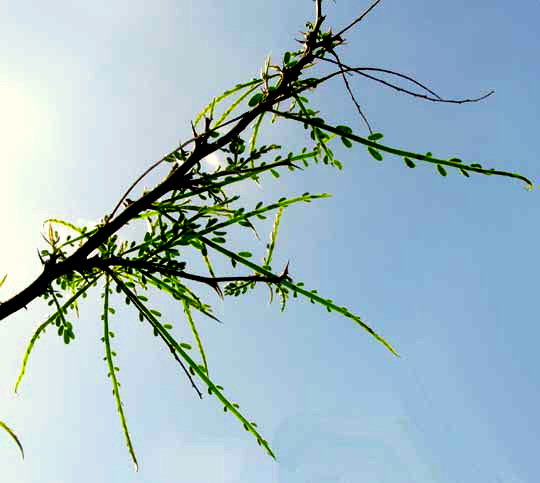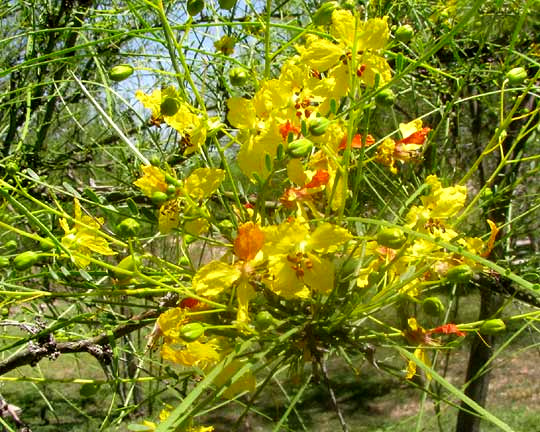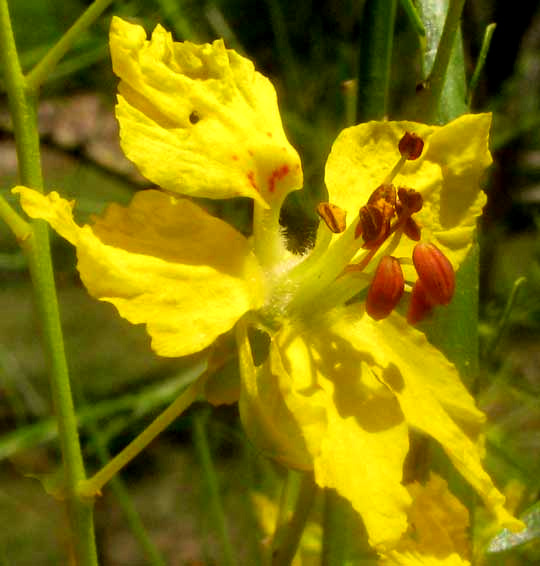Excerpts from Jim Conrad's
Naturalist Newsletter
from the April 6, 2014 Newsletter issued from the Frio Canyon Nature Education Center in the valley of the Dry Frio River in northern Uvalde County, southwestern Texas, on the southern border of the Edwards Plateau; elevation ~1750m (~5750 ft); N29.62°, W99.86°; USA
JERUSALEM-THORN'S LEAVES EXPANDING
The Jerusalem-thorn, PARKINSONIA ACULEATA, is a small tree native from central Texas south as far as northern South America and west to Arizona. A member of the Bean Family, later in the year it'll produce pretty clusters of yellow flowers, but right now it's only issuing leaves. However, the leaves are so strange-looking that they deserve attention just by themselves. You can see them issuing from spiny stems below:

Each of the items you might think is a pinnately compound leaf is actually one of two of a leaf's subdivision, and that subdivision, or pinna, is then further divided into the small, widely spaced leaflets you see. The twice-compound leaf has a very short stem, or petiole.
I've not seen Jerusalem-thorns along the upper Dry Frio but in the scrub around Uvalde 35 miles to the south and lower in elevation, they're common. Other names for Jerusalem-thorn include Paloverde, Retama and Lluvia de Oro.
Jerusalem-thorn is a member of the huge Bean Family. The "Jerusalem" in its name is what English speakers came up with when they heard Spanish speakers call it "Girasol," which in the name usually given to sunflowers, and means "turning toward the sun."
from the May 4, 2014 Newsletter issued from the Frio Canyon Nature Education Center in the valley of the Dry Frio River in northern Uvalde County, southwestern Texas, on the southern border of the Edwards Plateau; elevation ~1750m (~5750 ft); N29.62°, W99.86°; USA
JERUSALEM-THORN FLOWERING
Nowadays the Jerusalem-thorn's leaves are fully deployed, plus many branch-tips bear pretty bunches of yellow flowers, which can be admired below:

The individual flowers, about an inch across (2.5cm), are worth looking closely at, as you can see below:

Jerusalem-thorns are members of the Bean Family, but you can see that this flower doesn't display the pronounced bilateral symmetry of the typical bean-vine flower. Bilaterally symmetrical things have one side that is a mirror image of the other, but there's only one way the mirror can cut across the object. Our flower isn't quite "radially symmetrical," like a rose, but it almost is. This half-hearted bilateral symmetry is typical of the subfamily Jerusalem-thorn belongs to, the Caesalpinioideae -- cassias and sennas being the best-known members -- in which flowers are only slightly bilaterally symmetrical.
Paying special attention to its asymmetries, you can see that our flower is a little taller than wide. Also, only the topmost petal bears reddish spots at the bottom of its blade. The blossom's most conspicuous asymmetry, however, is with its stamens. Notice the large ones with plump, pink anthers at the bottom of the stamen cluster, with much smaller, browner anthers above, and some stamens are on stems, or filaments, longer than others.
from the July 27, 2014 Newsletter issued from the Frio Canyon Nature Education Center in the valley of the Dry Frio River in northern Uvalde County, southwestern Texas, on the southern border of the Edwards Plateau; elevation ~1750m (~5750 ft); N29.62°, W99.86°; USA
JERUSALEM THORN FRUITING
Nowadays Jerusalem Thorns bear both flowers and fruits, as shown below:

When we looked at the flowers it was almost hard to believe that Jerusalem Thorn is a member of the Bean Family, but seeing the few-seeded pods in this picture it's easier, the leathery pods being acceptable legumes. Legumes are simple fruits that split apart, or "dehisce," along two sutures, and arise from a flower's one-celled ovary. And of course legume seeds are called beans. Jerusalem Thorn fruits are famous for producing so few beans per fruit, so we can assume that once the beans germinate they enjoy a good survival rate.